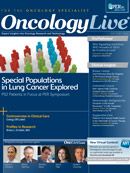Publication
Article
Oncology Live®
PointBreak Trial Misses Goals but Yields Clues for Maintenance Therapy
Author(s):
Despite missing its main goals, the PointBreak trial did provide guidance about how best to structure maintenance therapy in NSCLC, and it proved that an option besides paclitaxel is available.
Jyoti D. Patel, MD
"Point break" is a surfing term that refers to the sweet spot within a wave, according to Jyoti D. Patel, MD. But as principal investigator on a clinical trial named for the phenomenon, she never experienced such a perfect moment.
Patel and colleagues set out to explore whether a pemetrexed (Alimta)-based first-line and maintenance chemotherapy regimen would be superior to the standard combination protocol in the phase III PointBreak study. Instead of a superior regimen, investigators found that the outcomes with the pemetrexed strategy were equivalent to standard paclitaxel in prolonging overall survival (OS) when both were administered in the first-line setting in combination with carboplatin and bevacizumab (Avastin), Patel told an audience at the 7th Annual New York Lung Cancer Symposium.
Specifically, the trial randomized approximately 900 patients to receive either pemetrexed/carboplatin/bevacizumab followed by pemetrexed/bevacizumab (Pem Arm) or to paclitaxel/carboplatin/bevacizumab followed by bevacizumab (Pac Arm).
“Eight years and millions of dollars later, we still haven’t made a perceptible impact,” said Patel, associate professor of Hematology/Oncology at Northwestern University’s Robert H. Lurie Comprehensive Cancer Center in Chicago, Illinois. “It may be that what we need are better, smarter trials that detect differences in response earlier so we can get to those targeted treatments.”
The PointBreak trial did, however, provide guidance about how best to structure maintenance therapy in NSCLC, and it proved that an option besides paclitaxel—with a different toxicity profile—is available. While pemetrexed was associated with more fatigue and thrombocytopenia, the doctor said, paclitaxel caused more neutropenia, neuropathy, and alopecia.
Key Results Disappointing
As long as the payer system allows medicine choices that are not solely cost-based, Patel said, doctors should decide cooperatively, with patients, which of the two drugs is more acceptable. For instance, she said, “if the patient is a 40-year-old who is still working and uses a computer, neuropathy might be job-ending, and alopecia might be important.”PointBreak began enrolling patients in 2008 and met its data lock in May 2012. The randomized, open-label study, conducted in the United States, included patients with advanced, nonsquamous NSCLC who had a performance status of 0 or 1 and had not undergone prior systemic therapy, Patel reported.
Participants received four cycles of either pemetrexed or paclitaxel in combination with carboplatin and bevacizumab, she said. Those whose disease was stable or responsive after those cycles—about 60%—went on to maintenance therapy.
The primary endpoint was a 20% improvement in survival, and secondary endpoints were progression-free survival (PFS), time to progressive disease (TTPD), overall response rate (ORR), patient-reported outcomes, and safety. A prespecified exploratory analysis looked at OS and PFS in the maintenance therapy population, and another considered PFS without grade 4 toxicity.
Median PFS was 6.0 months in the Pem Arm versus 5.6 months in the Pac Arm, with a hazard ratio (HR) of 0.83. TTPD was 7.0 and 6.0 months in those arms, respectively, with an HR of 0.79. ORRs were 34.1% and 33% in the Pem Arm versus the Pac Arm, respectively, and median PFS without grade 4 toxicity was 4.3 months in the Pem Arm versus 3.0 months in the Pac Arm (HR = 0.74), Patel said.
In OS, she said, the two arms were even more closely matched. Median OS was 12.6 months in the Pem Arm versus 13.4 months in the Pac Arm, with an HR of 1.00 and a P value of .949. “There was no improvement with pemetrexed,” Patel confirmed.
Maintenance Patterns Intriguing
Patel noted, however, that the prespecified exploratory analysis of the maintenance therapy groups revealed an interesting pattern. Median PFS was 8.6 months for those taking both pemetrexed and bevacizumab, compared with 6.9 months for those taking bevacizumab alone, she reported. Median OS was 17.7 months in the dual-drug group versus 15.7 months in the single-agent group.
PointBreak: OS from Randomization (ITT)
Pem+Cb+Bev
Pac+Cb+Bev
OS median (mo)
12.6
13.4
HR (95% CI); P value
1.00 (0.86, 1.16); P=0.949
Survival rate (%)
1-year
52.7
54.1
2-year
24.4
21.2
Censoring rate for Pem+Cb+Bev was 27.8%; for Pac+Cb+Bev was 27.2%
Bev indicates bevacizumab; Cb, carboplatin; CI, confidence interval; HR, hazard ratio; ITT, intention to treat; OS, overall survival; Pac, paclitaxel; Pem, pemetrexed.
Patel JD. Choosing optimal therapy for advanced non-squamous (NS) non-small cell lung cancer. Presented at: 7th Annual New York Lung Cancer Symposium; November 10, 2012; New York, NY. Reprinted with permission.
“The results of the prespecified analyses are not statistically accurate, because they were done after the induction phase in a postrandomization population,” Patel said, “but if we focus just on the 60% of patients who did get to maintenance, it looks like there may be benefit in taking the two drugs over one.”
Patel J, Socinski MA, Garon EB, et al. A randomized, open-label, phase 3, superiority study of pemetrexed (Pem)+carboplatin (Cb)+bevacizumab (B) followed by maintenance Pem+B versus paclitaxel (Pac)+Cb+B followed by maintenance B in patients (pts) with stage IIIB or IV non-squamous nonsmall cell lung cancer (NS-NSCLC). Presented at: 2012 Chicago Multidisciplinary Symposium in Thoracic Oncology; September 7, 2012; Chicago, IL. Abstract LBPL1.









